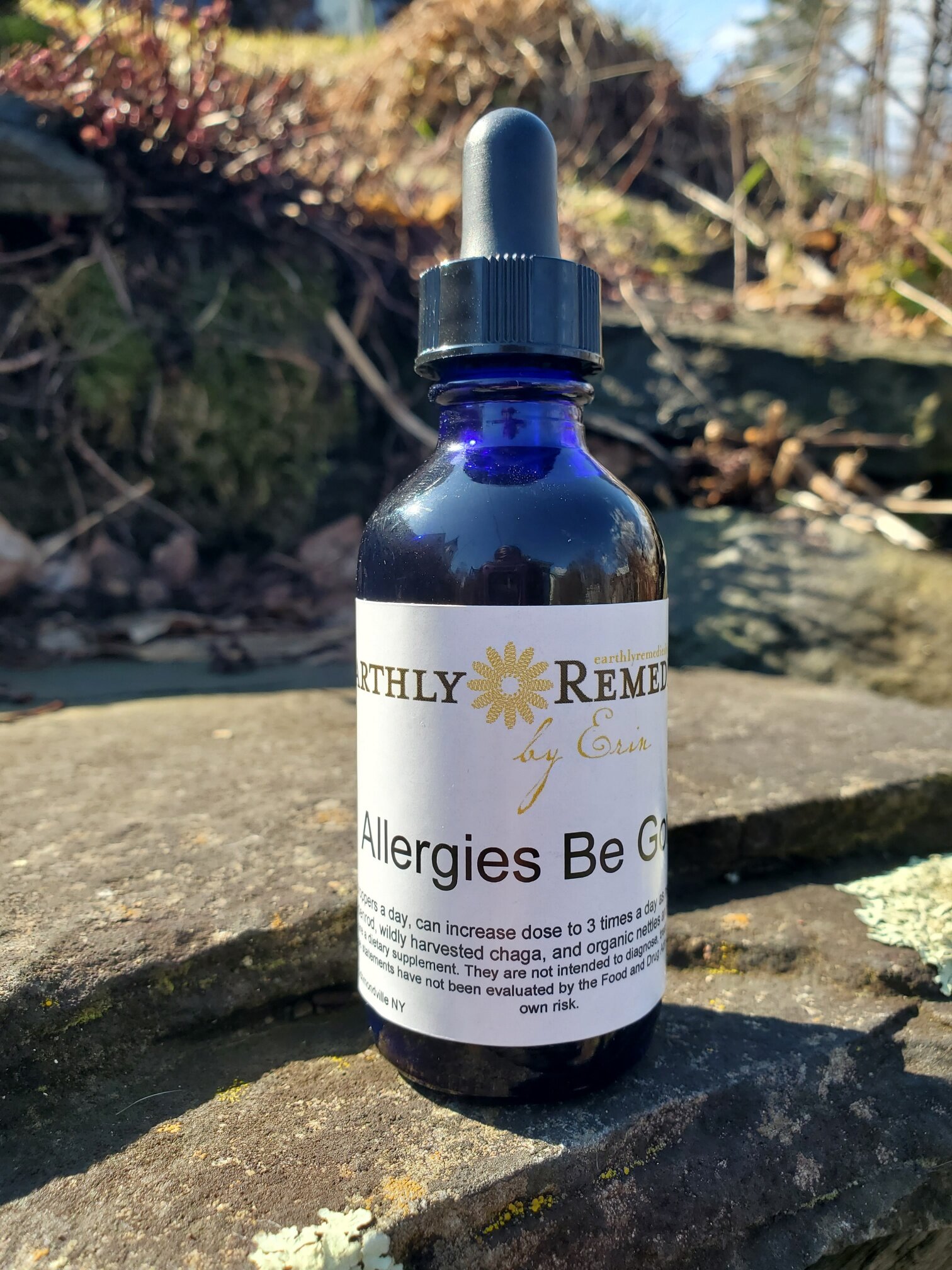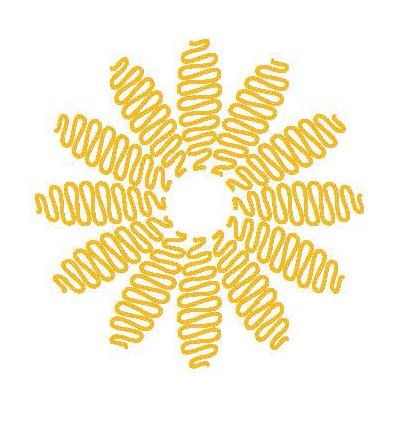Allergies be Gone 2 oz.


Allergies be Gone 2 oz.
Allergies be gone helps treat seasonal allergies. I have also found benefits from taking it for food allergies, but that is just my personal experience. Made with organic gluten free alcohol and wildly harvested nettles and golden rod.
Take 1-2 full droppers 2 times a day as needed.
Nettles (Urtica dioica) I am sure there are some of you who know nettles as stinging nettles. Maybe you have walked through a patch of it or stuck your hand in some. That stinging, burning sensation that engulfs the area that it touched can’t be missed or forgotten. As a kid, I remember being out in the fields with the sheep and horses and it was one of the few plants that was never eaten - there it was in a clump all by itself.
Nettles grows in many conditions and places – it really isn’t limited. You can find it where there was an old abandoned building, in fields, next to barns, in the garden, on the trail while hiking, or on the edge of compost piles. A lot of times you find it because you have bumped into it and feel the sting. The stinging sensation and skin irritation can last for a few hours and sometimes you still feel it the next day or two. Herbs like jewelweed and plantain can help reduce the pain from the nettles’ sting; if any happens to be growing nearby you can bruise the leaves and rub it onto the affected area. The sting is caused from the formic acid that is in the tiny hairs that grow on the stem. Those tiny hairs penetrate the skin, break off from the plant, and then release their chemicals. Ouch!
Despite the sting, nettles are a great medicinal herb to use for a variety of purposes. Nettles has antihistamine and anti-inflammatory properties making it great for seasonal allergies, hay fever, and asthma sufferers. Nettles is a good herb to start taking in the early spring, about 4-6 weeks before everything starts to go into bloom. The benefits of doing this is that you have a buildup in your body before the pollen from plants starts to show itself. I have also found it beneficial for dogs that suffer from allergies. The dried herb can be sprinkled into their food and consumed directly. Nettles is a good alterative which means it helps to purify the blood and eliminates waste so in turn it helps to detox the body. It is especially useful after a long winter of eating heavy food and not exercising as much. This makes drinking the tea or cooking with the young greens a great option in the early spring when using as a detox.
Nettles is an amazing herb used to support and strengthen the kidneys, adrenals, and prostate. It is highly nourishing to the blood and is beneficial for anemia. Because of the nutritional content and its ability to strengthen the adrenals it is good for afternoon lulls and can give you an energy boost when feeling fatigued. There have been some studies done using nettles for relief of lower urinary tract problems that have shown good results. Herbalist use nettles to help with reducing urinary frequency, strengthening kidney function, and to help decrease prostate size. Nettles drunk as an infusion or used as a hair rinse, acts as a restorative for weak hair and to promote hair growth where there is hair loss. Nettles is also good after pregnancy as it helps to increase breast milk. Because of its astringent properties it can also help with the uterine bleeding. It can be used any time there is excessive bleeding in the body.
Nettles can also be used for gout and arthritis. If you are brave and purposely want to try rubbing nettles up against the skin it has been used by many cultures to help with gout and arthritis pain. In the case of gout, it helps to break up that uric acid that has formed into clusters in the joints. There have been some beneficial clinical trials done using nettles cream for pain relief for osteoarthritis. During the summer I have purposely rubbed nettles onto my big toe for some gout pain and I have found relief - that doesn’t mean everyone should do it.
Nettles is best when harvested in the early spring. Using gloves and wearing a long sleeve shirt is recommended if you are going to try and harvest some yourself. Before harvesting make sure you are 100% certain what nettles looks like. Maybe take a foraging class or find a trained herbalist to help you identify it. (This goes for any herbs that you are interested in foraging yourself.) You can harvest the leaves, stem, and roots. When you harvest the leaves and stem in the spring you can sauté or steam it just like you would spinach – personally I have a hard time doing this. I do add the dried leaf to my soup broths and will consume it like that. I really love nettles because of its medicinal properties but that it can also be used as a food, and it can be consumed daily. Some like to juice the new spring greens. It is high in minerals and vitamins like chlorophyll, iron, silica, and calcium. Nettles is best used as a tea, infusion, food, or tincture. The mineral and vitamin content of the plant is best utilized when used as a food or an infusion/tea as the water helps to draw out these properties. The seeds are also used and can be eaten directly. I typically harvest those at the end of August and into September.
Goldenrod (Solidago spp.) unfortunately has a bad reputation – an unjustified bad reputation. A lot of people that I speak with always seem to think that they are allergic to goldenrod and that it is the main culprit for their seasonal allergies. Well, that is just the opposite. You can actually use goldenrod to treat seasonal allergies. And most people are allergic to the ragweed that grows alongside of goldenrod the same time of year. That doesn’t mean you can’t truly be allergic to goldenrod but what typically brings on those seasonal allergies is ragweed. Goldenrod pollen is relatively heavy and so when the wind blows it doesn’t go far - it falls to the ground rather quickly - unlike the pollen of ragweed which gets into the air and can stay in the air. Some people can even get contact dermatitis from touching ragweed.
Goldenrod has over 100 different species! They have the ability to cross pollinate with each other creating their own hybrid species. They can all be used interchangeably for medicinal purposes. It is in the aster family and grows world-wide. It likes sunny locations, so you often see it in abundance in fields and along roadsides. Goldenrod is in bloom from July through September in the northeast. Plants can grow and reach upwards of 7 feet tall, but they can also be only a foot or two tall. It has bright yellow raceme flowers that grow off a hairy stem. Make sure you can properly identify goldenrod. I always recommend checking with an herbalist or forager who can properly identify plants if you have any questions.
The whole plant can be used for medicine. It is sometimes referred to as the north’s arnica because we have a hard time growing arnica here but not goldenrod. The benefits are similar and can be used for bruising and swelling the same way one would use arnica. It has anti-inflammatory and antispasmodic effect. The arnica muscle rub has both arnica and goldenrod in it. I like how the two plants work together because I feel that it makes a stronger pain reliever than when I use them separately.
If one wanted to try their hand at making some goldenrod oil, you just need to pick off each flower separately (yes very tedious and time-consuming) and place it in a jar with your oil of choice. Make sure the flowers stay fully submerged in the oil and place the jar of oil in a sunny location for a few weeks. After you can strain out the flowers and use the oil on bruises, swelling, body aches and even to help with healing burns, wounds, and skin ulcers. Though don’t directly apply it to open wounds. It has a wonderful aroma afterwards and is one of my favorite oils to make. There are records that show the Native Americans used goldenrod flowers and roots for burns, boils, ulcers and more.
I had mentioned that goldenrod is good for allergies. Goldenrod helps the upper respiratory system by drying out the mucosa. So, it isn’t just beneficial for allergies, it is also beneficial for sinuses and colds and can be used as a decongestant.
Goldenrod is also used for the urinary system because of its anti-inflammatory, antimicrobial, and astringent properties. It helps urinary infections by easing pain and spasms and has been beneficial for cystitis. Its diuretic effects also help with kidney stones and gout. Goldenrod blended with nettles makes a great tea for kidney support, look for this new product coming in 2025.
According to folk lore, goldenrod is tied to prosperity, good luck, and water. It is said where there is goldenrod growing there is a spring or water nearby. The stem was used for divining rods which are also known as dowsing rods. Early the Boston Tea Party settlers used goldenrod for tea and it was a key ingredient in “liberty teas” – which were even exported to China.
This is a dietary supplement.
I recommend that with all the herbal tinctures you start of small in dosing and work your way up to recommended dosage. Some people only need a small amount to notice a difference.
Disclaimer: Earthly Remedies is not responsible for any individual’s use of our products. Each person’s response to herbs may differ. Consult a qualified health care practitioner or herbalist for guidance.
*These statements have not been evaluated by the Food and Drug Administration. These products are not intended to diagnose, treat, cure or prevent any disease.

